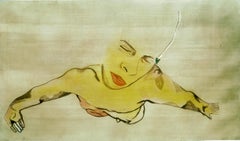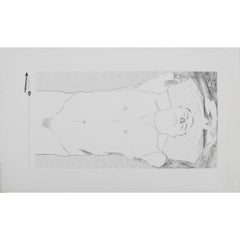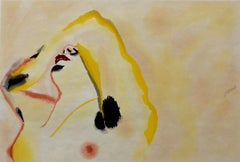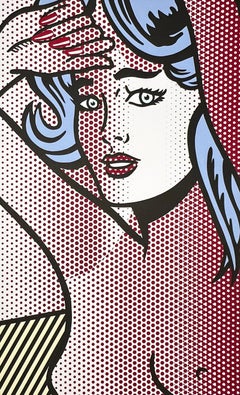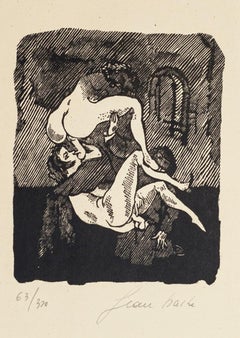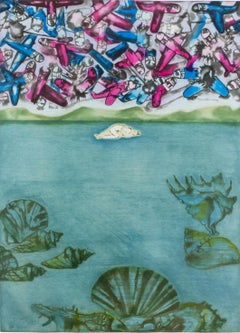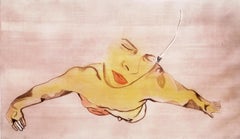Francesco Clemente Nude Prints
to
1
2
Overall Width
to
Overall Height
to
1
37
93
62
56
56
3
2
3
2
2
1
1
1
1
1
1
2
2
1
1
1
2
1
Artist: Francesco Clemente
Semen: large scale expressionist nude male figure portrait, floating in pink
By Francesco Clemente
Located in New York, NY
This large scale, ethereal portrait depicts a tranquil male nude figure floating in pink and blue. Based on a tempera painting, an expressionist, emotive piece to bring dramatic impa...
Category
1980s Contemporary Francesco Clemente Nude Prints
Materials
Drypoint, Etching, Aquatint
Francesco Clemente - Hand-Signed Drypoint on Paper, 2/23
By Francesco Clemente
Located in Varese, IT
Francesco Clemente ( 1952 ) - hand-signed drypoint on paper - 74 x 124 cm, 2/23
Additional information:
Material: Drypoint on paper
Very limited edition, numbered in lower left corn...
Category
20th Century Francesco Clemente Nude Prints
Materials
Paper, Drypoint
Morning - Italian Art Original Hand Signed and Inscribed Woodcut Nude Woman
By Francesco Clemente
Located in London, GB
FRANCESCO CLEMENTE b. 1952
Naples 1952 (Italian)
Title: Morning, 1981/82
Technique: Original Hand Signed, Dated, Titled and Inscribed Woodcut in Colours on Japan Paper
Paper size...
Category
1980s Francesco Clemente Nude Prints
Materials
Woodcut
Related Items
Nude With Blue Hair
By Roy Lichtenstein
Located in Washington, DC
Artist: Roy Lichtenstein
Title: Nude With Blue Hair
Medium: Relief print on Rives BFK mold-made paper
Date: 1994
Edition: 28/40
Sheet Size: 57 7/8" x 37 5/8"
Image Size: 51 5/16" x 3...
Category
1990s Pop Art Francesco Clemente Nude Prints
Materials
Woodcut
Erotic Scene - Woodcut by Mino Maccari - 1944
By Mino Maccari
Located in Roma, IT
Erotic Scene is an original xilography artwork realized by Mino Maccari in 1944. Hand-signed in the pseudonym of "Jean Baschie" which is the artist's signature in 1944 erotic series artwork...
Category
1940s Francesco Clemente Nude Prints
Materials
Woodcut
$305 Sale Price
35% Off
H 8.27 in W 6.11 in D 0.04 in
Aphrodite - Héliogravure and Drypoint attr. to Salvador Dali - 1963
By Salvador Dalí
Located in Roma, IT
Attr. to S. Dalì, "Aphrodite", Heliogravure and dry-point. Paris, Argillet. 1963-65.
Image dimensions 49,2 x 39,7 cm.
Beautiful Proof on vélin filigrané “Arches”, Signed and Dated...
Category
1960s Surrealist Francesco Clemente Nude Prints
Materials
Drypoint
$3,407
H 25.79 in W 19.69 in D 0.04 in
Le Couple
By Pablo Picasso
Located in New York, NY
Pablo Picasso (1881-1973), Le Couple, 1951, drypoint on chine volant, signed lower right margin and numbered (5/XI) lower left margin. References: Bloch 690,...
Category
1950s Cubist Francesco Clemente Nude Prints
Materials
Drypoint
Purgatory Canto 22 - Prodigality, Surrealist Woodcut by Salvador Dalí
By Salvador Dalí
Located in Long Island City, NY
Salvador Dali, Spanish (1904 -1989) - Purgatory Canto 22 - Prodigality, Portfolio: The Divine Comedy, Year: 1964, Medium: Woodcut, signed and numbered in red pencil, Edition: 126...
Category
1960s Surrealist Francesco Clemente Nude Prints
Materials
Woodcut
Rising I, Male nude lithograph by Trevor Southey
By Trevor Southey
Located in Palm Springs, CA
Male nude lithograph by Trevor Southey. Charcoal gray. There was also an edition done in terra cotta.
Trevor Southey was born in Rhodesia, Africa (now Zimbabwe) in 1940. His African...
Category
1980s Contemporary Francesco Clemente Nude Prints
Materials
Lithograph
Seishi Ai-oi Genji – Set of 12 Shunga works together w/astrological commentary
By Utagawa Kunisada (Toyokuni III)
Located in Middletown, NY
Set of 12 woodblock prints in colors on handmade, laid mulberry paper, 6 3/4 x 10 1/4 inches (170 x 258 mm), printed in Ka-ei 4 (1851). Each print with minor handling wear, otherwise in excellent condition with bright and fresh color, and with details printed in silver ink. The images themselves contain several illusive characters indicating the publisher which are obfuscated by figures, as intended. Presented loose, as issued. A fine set.
The astrological commentary print has a large and meandering blind stamp with a bird and palm frond motif. This print lists various phrases concerning the Twelve Zodiac Animals as historically counted in Japan, and appears to include erotic commentary on the traits of people born under each of the twelve signs.
These Shunga images were issued in books that paralleled (in an erotic fashion...
Category
Mid-19th Century Edo Francesco Clemente Nude Prints
Materials
Ink, Handmade Paper, Woodcut
Contemporary Nude Etching by John Emanuel
By John Emanuel
Located in Brecon, Powys
Signed Limited Edition Etching 32 of 75
the artist more known for his Gouache and Oil paintings has here put his hand to an etching.
Image 16" x 11"
Category
21st Century and Contemporary Contemporary Francesco Clemente Nude Prints
Materials
Paper
Shell Shedding, by Trevor Southey
By Trevor Southey
Located in Palm Springs, CA
Pencil signed, titled, and numbered 46/55 in the margin. Artist: Trevor Southey
Title: "Shell Shedding"
Medium: Drypoint Etching
Edition: 46/55
Male nude against an abstract back...
Category
1980s Contemporary Francesco Clemente Nude Prints
Materials
Drypoint, Etching
"Mais O Belle Dionee" from the suite "lArt d'Aimer d'Ovide"
By Salvador Dalí
Located in San Francisco, CA
This artwork titled, "Mais O Belle Dionee" from the suite, "l'Art d'Aimer d'Ovide" 1976. is an original wood engraving on Japan nacre paper by artist Salvador Dali 1904-1989. It is...
Category
Late 20th Century Surrealist Francesco Clemente Nude Prints
Materials
Woodcut
$2,450
H 31.75 in W 24.5 in D 1 in
Autoportrait a la Canne, Avec Comedien, Amour Replet et Femmes (Bl. 1488)
By Pablo Picasso
Located in Aventura, FL
Etching on BFK Rives paper, Plate 8 from series 347. Hand signed lower right by Pablo Picasso. Hand numbered 11/50 lower left (there were also 17 artist's proofs). Sheet size: 24 ...
Category
1960s Cubist Francesco Clemente Nude Prints
Materials
Paper, Etching
$28,000 Sale Price
20% Off
H 37 in W 33.75 in D 1 in
1945 Brazilian Master, Art Deco Nudes Serigraph Woodcut Carnaval Bahia
By Odetto Guersoni
Located in Surfside, FL
Genre: Brazilian Art Deco, African Diaspora
Bahian Carnival
Subject: Abstract
Medium: Print
Surface: Paper
Country: Brazil
Dimensions of overall paper are listed.
This is from a series of work he did in the 1940's, we sold one called Ritmo Negro, they are about Afro-Brazilian jazz, dance and music.
Odetto Guersoni was born in the city of Jaboticabal, State of São Paulo, in 1924. From 1936 to 1941 he attended the Liceu de Artes de Ofícios in São Paulo, beginning his artistic career in 1945, when he exhibited paintings in the Hall of the Plastic Artists Union . Two years later he was part of the collective group of 19, alongside Aldemir, Charoux, Otavio Araújo, Grassmann, Maria Leontina and several other artists that time would make famous. He then practiced a figurative painting of accentuated Expressionist lauds, characterized by deformation and coloring, raw and Satirical- as, moreover, so many of his fellow exhibitors at the time. As a French government scholar, Odette Guerzoni went to Paris in 1947 and the following year took part in the Peintres et Graveurs Etrangers and Art Libre exhibitions. Student of engraving by Renê Cottet, gradually transformed this expressive medium into his favorite, to the detriment of painting, which he practically abandoned soon after.
In 1947, he participated in the 19 Painters exhibition at the Prestes Maia Gallery together with Lothar Charoux, Maria Leontina,Grassmann, Aldemir Martins, Luiz Sacilotto and hiró. Guersoni was awarded a scholarship by the French government, and traveled to Paris, where he began work in engraving. Back in Brazil, in 1951, he founded the Art Workshop, in São Paulo. In 1954, he returned to Europe for a year, financed by the International Labor Organization (ILO). In Geneva, he studied engraving with René Cottet (1902 - 1992) and worked in Stanley william Hayter's studio, Atelier 17, in Paris (1901 - 1988). From 1956 to 1957, he became director of the Union of Plastic Artists of São Paulo. From 1960, he attended, as a trainee, some art schools in the United States and Japan such as The New York School of Printing and Osaka University. In 1971, also in Japan, he attended the workshop of I. Jokuriti. Two years later, he was voted Best Recorder of the Year by the Paulista Association of Art Critics - APCA. He took part in a special room at the Ibero-American Biennial in Montevideo in 1983. The Pinacoteca do Estado de São Paulo - Pesp presents a retrospective of his work in 1994.
Odetto Guersoni explores the wide spectrum of possibilities of the engraving. In addition to using techniques such as metal etching, lithograph, serigraph, linocut and, especially, woodcut he developed, in the 1950s, the philigraphy, in which the forms he developed gained points of embroidery made by Bonadei (1906 - 1974) . And, in the 1960s, the plastigraphy, in which he makes engravings on pasty surfaces, obtained from gypsum or other soft material. In the 1970s, technical investigations were associated with pictographic, ideographic, archaic symbol searches, Brazilian cave paintings and plant forms. The drawings are reduced to stylized, geometric shapes and transformed into abstract graphic elements. The artist works with few matrices, which, organized in rectangles, squares or circles, become modules to be combined. Guersoni juxtaposes them, adds, changes colors, and thereby composes colorful mandalas and structural geometries. Based on concise compositions, it produces color vibrations through optical illusions. In many of his woodcut works of the 1980s he uses smooth wood, knives, saws, gouges, punches, avoiding the natural textures of wood. In printing, it leaves the vibrant color and employs dosed inks with colorless masses, obtaining transparencies by superpositions. New journeys of study and specialization in engraving techniques took him in 1954 to Switzerland, 1960 to the United States, and in 1966 to Germany and Austria. Today, after having performed more than 40 individuals including 16 abroad and having participated in more than 50 collectives in several countries, Guersoni is considered one of the most notable Brazilian engravers. Conquered awards in several shows.
CHRONOLOGY
Individual exhibitions
1946 - Sao Paulo SP - 10th Salon of the Artists' Union, at the Prestes Maia Gallery
1947 - São Paulo SP - 19 Painters, at the Prestes Maia Gallery
1948 - Paris France - Peintres et Graveurs Etrangers at the École des Beaux-Arts
1949 - São Paulo SP - 13th Salon of the Artists' Union, at the Prestes Maia Gallery
1951 - São Paulo SP - 1st Paulista Salon of Modern Art, at Prestes Maia Gallery - silver medal
1953 - São Paulo SP - 2nd International Biennial of São Paulo, at MAM / SP
1954 - São Paulo SP - 3rd Paulista Salon of Modern Art, in the Prestes Maia Gallery
1955 - Rio de Janeiro RJ - 4th National Salon of Modern Art
1955 - Salvador BA - 5th Baiano Salon of Fine Arts, in Belvedere da Sé - honorable mention
1962 - São Paulo SP - Leirner Prize for Contemporary Art at the Folha Art Gallery - 1st printing award
1963 - Curitiba PR - 20th Salão Paranaense de Belas Artes, at the Public Library of Paraná
1963 - Rio de Janeiro RJ - Individual, no MAM / RJ
1968 - Bradford England - First International Print Biennale
1970 - São Paulo SP - Antonio Henrique Amaral, Odetto Guersoni, Tomie Ohtake, Pedro Tort and Gerda Brentani, in the Alberto Bonfiglioli Gallery
1971 - São Paulo SP - 11th International Biennial of São Paulo, at the Biennial Foundation - acquisition award
1973 - Punta del Este Uruguay - 1st Engraving Meeting of the Prata Basin Countries - International Prize
1977 - São Paulo SP - The Groups: the 40's, at the Lasar Segall Museum
1982 - São Paulo SP - Ismenia Coaracy, Odetto Guersoni and Alice Brill...
Category
1940s Art Deco Francesco Clemente Nude Prints
Materials
Woodcut
$600
H 8.5 in W 12 in D 0.1 in
Previously Available Items
Conception: birth of Venus, lovers, pink blue fighter planes, ocean landscape
By Francesco Clemente
Located in New York, NY
This large, bright blue and neon pink Francesco Clemente etching features two nude lovers in a turquoise ocean stretching towards the viewer. Seashells in shades of green ornament ei...
Category
1980s Contemporary Francesco Clemente Nude Prints
Materials
Etching
Semen: large scale expressionist nude male figure portrait, floating in pink
By Francesco Clemente
Located in New York, NY
This large scale, ethereal portrait depicts a tranquil male nude figure floating in pink and blue. Based on a tempura painting, an expressionist, emotive piece to bring dramatic impa...
Category
1980s Contemporary Francesco Clemente Nude Prints
Materials
Drypoint, Etching, Aquatint
Conception: birth of Venus, lovers, pink blue fighter planes, ocean landscape
By Francesco Clemente
Located in New York, NY
This large, bright blue and neon pink Francesco Clemente etching features two nude lovers in a turquoise ocean stretching towards the viewer. Seashells in shades of green ornament ei...
Category
1980s Contemporary Francesco Clemente Nude Prints
Materials
Etching
Francesco Clemente nude prints for sale on 1stDibs.
Find a wide variety of authentic Francesco Clemente nude prints available for sale on 1stDibs. If you’re browsing the collection of nude prints to introduce a pop of color in a neutral corner of your living room or bedroom, you can find work that includes elements of blue and other colors. You can also browse by medium to find art by Francesco Clemente in drypoint, engraving, etching and more. Much of the original work by this artist or collective was created during the 20th century and is mostly associated with the contemporary style. Not every interior allows for large Francesco Clemente nude prints, so small editions measuring 23 inches across are available. Customers who are interested in this artist might also find the work of Giacomo Manzú, Douglas Hofmann, and John Mazlish. Francesco Clemente nude prints prices can differ depending upon medium, time period and other attributes. On 1stDibs, the price for these items starts at $3,000 and tops out at $7,200, while the average work can sell for $4,347.
